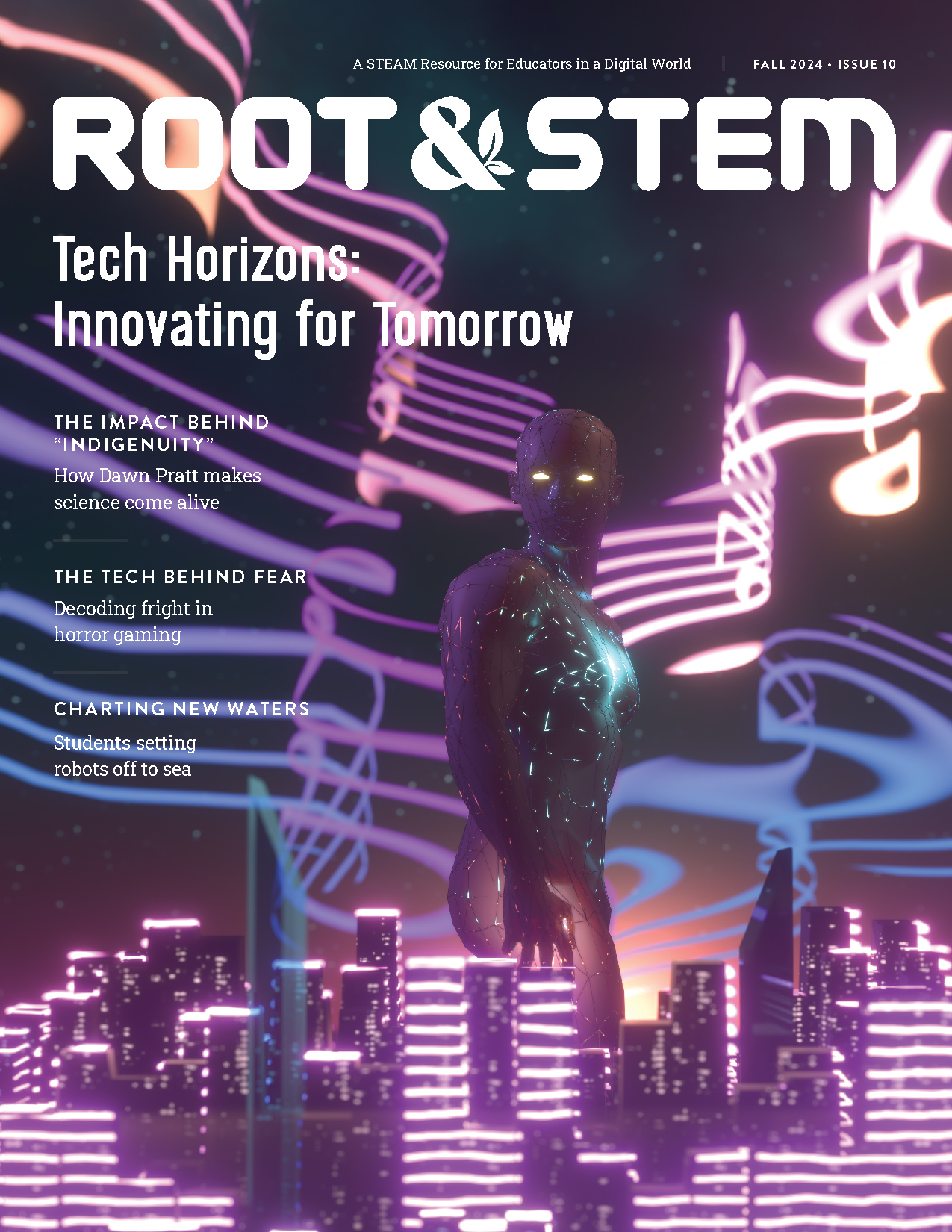This issue of Root & STEM explores the ways in which we can foster curiosity and problem-solving skills through cutting-edge technology, encouraging the next generation of innovators and creators. With a focus on robotics, coding, and digital technology, this issue aims to encompass the exploration, development, and utilization of technological innovations to create positive change with a human-centred approach.
This publication is funded in part by the Government of Canada.

Guest Editorial
Computing for Indigenous Communities
As an artist and professor, I weave together nehiyaw (Plains Cree) cultural narratives with technology. My goal is to transform computing technologies into a medium that reflects Indigenous traditions and engages Indigenous people, particularly youth. To further this endeavour, I contribute my expertise in Indigenous-focused computing by serving as a fact-checker for the Government of Ontario’s Grade 10 Computer Science curriculum.
In computer science education, fostering inclusivity and diversity is essential to create meaningful learning experiences that resonate with all students. The Government of Ontario’s consultation with Indigenous and subject matter experts like myself is crucial, as it ensures the educational landscape in computer studies is equitable and inclusive and makes the world of information and communication technology more welcoming and diverse, a world where every student sees their culture and identity reflected and valued in their learning journey.
Indigenous Language Interfaces
It is essential to acknowledge the significance of language in cultures, particularly for Indigenous and other colonized communities. Language carries the wisdom, traditions, and identity of a people. Thus, developing language translation software and applications that support Indigenous languages is crucial in making technology accessible and relevant.
One of the most significant obstacles that stands in the way of computer usage in Indigenous communities stems from the dominance of English-language interfaces, which can alienate individuals who communicate primarily in languages other than English. Recognizing the importance of maintaining the vitality of Indigenous languages and fostering cultural pride, initiatives focusing on Indigenous language interfaces continue to grow.
Adaptive technologies can re-imagine user interfaces by integrating Indigenous languages, orthographies, and cultural symbols and references, broadening the accessibility and cultural relevance of computing for users whose primary language is not English. For example, software applications and operating systems can offer language options tailored to specific Indigenous communities, empowering users to navigate digital platforms in their mother tongues.
By embracing Indigenous language interfaces, computing becomes a tool for communication and productivity for speakers of these languages, as well as a means of cultural preservation and revitalization. Moreover, incorporating Indigenous perspectives into software design and development nurtures a sense of ownership and belonging within Indigenous communities, challenging the notion that computers are culturally invasive.
Community-Centred Technology
In Indigenous communities where skepticism or apprehension towards technology prevails, traditional approaches to computer education may fall short. Community-centred technology workshops can offer promising solutions to address concerns and cultivate a culture of technological empowerment.

These inclusive initiatives prioritize community engagement and participation by tailoring computer education to align with Indigenous cultural values, traditions, and learning styles. Participants gain practical skills through hands-on activities, storytelling, and collaborative problem-solving while reaffirming their cultural identities. In British Columbia, for example, Simon Fraser University’s School of Interactive Art and Design hosts an annual computational arts workshop for Indigenous high school students from rural school districts. The all-day event exposes these students to the ways post-secondary educational pursuits can support cultural practices and languages that are unique to Indigenous students.
Community engagement workshops can also serve as platforms for intergenerational knowledge exchange, bridging the digital divide between Elders and youth. By encouraging dialogue and mutual respect, these workshops empower Indigenous communities to harness the benefits of technology while safeguarding their cultural heritage.
Adaptive and inclusive computing solutions hold tremendous potential in empowering Indigenous communities and bridging the digital divide. In prioritizing cultural sensitivity, linguistic diversity, and community engagement, initiatives such as Indigenous language interfaces and community-centred technology workshops pave the way for equitable access to computing technologies.
Featured Content
Below is a collection of stories, and comics featured in the tenth issue of Root & STEM.
